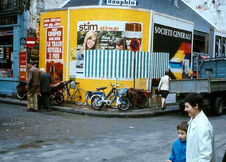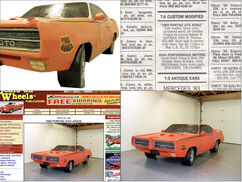
Guerrilla Girls, Billboard, Do Women Have to be Naked to Get into a Museum? (billboard) (1989)
Works of art that use billboards:
- Michael Ashkin, For Months He Lived Between the Billboards (later renamed "No. 2") (1993)
- front architects, Single Hauz (2007): architecture that look like billboards
- James Rosenquist, F-111 (detail) (1964-5): Before he gained sufficient enough funds to live solely off his art, the pop artist worked as a freelance painter for billboard advertisements (some documentation of his early career can be found here, taken from Painting Below Zero: Notes on a Life in Art). A lot of his paintings (including the one in the link above) still retain that flashy, largescale feel of billboard advertisement.
- Felix Gonzalez-Torres, Untitled (1991): After his lover Ross passed away, the artist displayed images of an absent body mark imprint on the bed on billboards all over NYC in memory of his lost love. It was also a subtle reminder to those whose lives were cut short by AIDs (which later caused Gonzalez-Torres' life to end tragically short as well). He also did another series of billboards like this one (Untitled (1995), El Paso, TX)
- Jenny Holzer, Survival Series: Protect Me From What I Want (New York Times Square, 1985-6)
- Rubén Ortiz-Torres, Albures Mexicanos (1984)
- Tacita Dean, The Story of Beard (1992): the photographic image (filmstill from an 8-min film) based off of Manet's famous Le Déjeuner sur l’herbe (1863) was displayed on a billboard. Unfortunately, the billboard version is not available online, but it can be found in No. 1: First Works by 362 Artists, eds. Francesca Richer and Matthew Rosenzweig.
- Guerrilla Girls, Billboard, Do Women Have to be Naked to Get into a Museum? (billboard) (1989)
- Doug Fogelson, 35th & Ashland (2011)
- Gran Fury, Kissing Doesn't Kill (1989, Chicago City Transit), Welcome to America (1989)
- Jennifer Bornstein, How Many Billboards: The End (2010)
- Barbara Kruger, Your body is a battleground (1990)
- Broken City Lab, Talking to Walls (2010)
- Mario Ybarra, Jr., Go Tell It (2005)
- KAWS, Kaws x Undefeated Billboard (2004)
- Carl Smool, Hollywood Bowled Over by Neutron Bomb (Altered Billboard, 1st Ave. and Bell Street, Seattle. 1981): Originally, the billboard said, "Hollywood Bowled Over by Kent III Taste!" Smool altered this billboard in response to Reagan's authorization of the renewed production of neutron bombs, which in turn created a media sensation. Smool admits to having had borrowed the idea from Mark Pauline.
- Mark Pauline: before serving as one of the founding members of the violent, anarchic-leaning Survival Research Laboratories group, Pauline made his claim to fame by altering billboard advertisements in San Fransisco from the mid-1970s to the early 1980s. He often did these alterations in public in front of an audience of amused spectators. [Unfortunately, visual documentation is difficult to find.]
- Billboard Liberation Front (BLF): an anti-marketing, anti-corporate campaign sponsored by a loose-knit cooperative that has been doing illegal billboard alterations since its somewhat mythic origins in the late 1970s with artists Jack Napier and Irving Glikk, and a group of artists known as "Max Factor 26." They now document their interventions on an ancillary online image blogging site (linked above). [see Mark Dery's article Culture Jamming: Hacking, Slashing and Sniping in the Empire of Signs for more on the topic.]
- Martha Rosler, Messages to the Public (1989): a project of the Public Art Fund, Times Square Spectacolor Sign.
- Zoe Strauss, "La Corona," Billboard Project (2012)
- Robert Walker, Rue Ste-Catherine Est, Montreal (1990)
Publicity:
- Chris Burden, TV Hijack (1972)
- Iain and Ingrid Baxter, N.E. Thing Co. (1966-78): the pair founded a fake company that acted as "advisers" to artist and art dealers.
- AIDS Coalition to Unleash Power (ACT UP), Silence = Death ad campaign (1987): although not seen as an art project per se, it was taken up by several artists. Many artists and creative inidividuals were afflicted with AIDS, and died due to AIDS-related illnesses, including:
- Klaus Nomi (1983), Jackie Curtis (1985), Hugues Autexier (1986), Bernard Pierre Wolff (1985), François Braunschweig (1986), Jack Boulton (1987), Bill King (1987), Peter Hujar (1987), Antonio Lopez (1987), Sam Wagstaff (1987), Bill Conners (1988), Alvin Ailey (1989), Bruce Chatwin (1989), Mark Morrisroe (1989), Norman Eales (1989), Jack Smith (1989), Robert Mapplethorpe (1989), Daniel Boudinet (1990), Scott Burton (1990), Kieth Haring (1990), Jimmy De Sana (1990), Tseng Kwong Chi (1990), Hervé Guibert (1991), Adrian Kellard (1991), Tina Chow (1992), David Wojnarowicz (1992), Crawford Barton (1993), Leigh Bowery (1994), Marlon Riggs (1994), Derek Jarman (1994), James Merrill (1995), Paul Montette (1995), Félix González-Torres (1996), Peter Adair (1996), David Seidner (2000) Frank Moore (2002), Herb Ritts (2002)
- Shephard Fairey, Obey Giant campaign (1989-present)
- Ellen Gallagher, DeLuxe (2004-5)
Appropriating advertisement or advertisement techniques:
- Richard Prince, Marlboro Man (1987)
- Stephen Prina, A Structural Analysis and Reconstruction of MS7098 as Determined by the Difference Bteween the Measurements of Duration and Displacement (1980 - 12 in. phonographic record), Design Program (1984 - poster, merchandising display, and publicity photograph), Reconstituted Arrangement (1990 - two phonograph records, framed poster, merchandising display, framed publicity photograph, integrated amplifier, turntable, headphones, table, and two chairs)
- Jeff Wall, Insomnia (1994): the photographer worked with lightboxes, typically used by advertisers in public spaces such as airports, bus shelters, train stations, and movie theatres.
- Doug Minkler, Draw Columbus (1991): Minkler plays off ads from the 1970s that asked the viewer to draw a particular image (in the likeness shown) for a chance at getting into art school. In this one, he asks the viewer to view revisionist history that portrays Columbus for his actions, not the heroic way he is portrayed in school textbooks. In Barfboro (1991), he spoofs cigarette ads.
- Barbara Kruger, Untitled (I shop therefore I am) (1980): Kruger was most famous for creating very direct feminist propoganda campaigns with flashy design techniques commonly used by advertisers at the time.
- Mimmo Rotella, With a Smile (1962): (see décollage)
Posters, graffiti fliers, street signs:

Daniel Buren, untitled (Paris, April 1968)
- Toulouse Lautrec, Moulin Rouge: La Goulue (1891)
- Vladimir Mayakovsky, Want it? Enter (Agitprop poster) (circa 1920)
- Daniel Buren, untitled (post graffiti) (Paris, April 1968)
- Victor Burgin, US77 (detail) (1977)
- Andy Warhol, The Thirteen Most Wanted (New York Police Department, 1962) (1962)
- Keith Haring creating a graffiti mural in a NY subway station (circa 1981)
- Dennis Adams, bus shelters series (1983-6): in another similar series, the artist worked with the American Indian Movement (AIM) and displayed images from the massacre at Wounded Knee in backlit signage kiosks of bus shelters, normally used by advertisers.
- KAWS, New York, milk (1997)
Magazines, pamphlets, and newspapers:
- Dan Graham, Figurative (originally in 1965, also in Harper’s Bazaar, March 1968, placed between a Tampax ad and an ad for a Torpedo bra), Homes for America (1966-7, "ad" in Arts Magazine)
- Lynda Benglis, untitled ad submitted to Artforum (1974)
- John Heartfield, Hurray! The Butter is All Gone! (1935): Heartfield's satirical response to Goering's statements in the Hamburg address: "Iron ore has made the Reich strong. Butter and dripping have at most made people fat." A member of the Berlin Dadaist group, and an avid left-wing pacifist, Heartfield became editor of the satirical magazine, Der Knöppel, and also worked for the socialist magazine, A.I.Z., where he used photomontage to attack Adolf Hitler and his Nazi Party, until he was forced to leave Germany in 1938.
- Claude Cahun: after the Nazi occupation of France, the French surrealist artist Claude Cahun and her lover/step-sister Suzanne Malherbe (i.e. "Marcel Moore") produced anti-Nazi fliers, often by pasting together snippets from English-to-German translations of BBC reports on the Nazi's crimes and insolence to create rhythmic poems and harsh criticism. The pair dressed up as Nazi solidiers and attended Nazi military events in Jersey, sneaking anti-Nazi pamphlets into soldiers' pockets. In 1944 they were finally caught, arrested and sentenced to death, but the sentences were never carried out. However, Cahun's health never recovered from her treatment in jail, and she died in 1954. Malherbe never emotionally recovered from her loss and committed suicide in 1972 (more info here).
- Iké Udé, Cover Girls: Cigar Aficionado (1997)
- Hattie Stewart, Magazine Cover Illustrations (ongoing series)
- Jeff Koons, Advertisement in Art in America (1988), Made in Heaven – Starring: Jeff Koons and Cicciolina (1989)
Online ad space, tactical media:

Conrad Bakker, Untitled Project: MUSCLE CAR, 1969 Pontiac GTO Judge (2004)
- Vuk Ćosić, net.art per se (1996): a fake CNN website that replicates the actual CNN website, but with references to net.art.
- etoy, Toywar (1999-2000): "a website headquarters for a defensive campaign resulting from a legal dispute between etoy, which had been online since 1995, and eToys, a relatively new dotcom business, which aimed to dominate the online children's toy network. The latter used its substantial financial resources to sue etoy for its domain name, alleging that etoy's site contained 'pornographic and anarchic' content that threatened its business. The lawyers were successful in this regard, and at one point a court injunction shut down the etoy website." Rachel Greene, Internet Art (126). Eventually eToys dropped the lawsuit after ®tmark caused their stocks to plummet right before Christmas with a campaign that flooded eToys with emails and mass postings to financial message boards.
- ®tmark, Barbie Liberation Organization (1993) (youtube video of local news documenting the event)
- Conrad Bakker, Untitled Project: MUSCLE CAR, 1969 Pontiac GTO Judge (2004): this artist liked to take trompe l'oeil to another level with his fooling unsuspecting buyers on ebay, who think they're buying a real muscle car when in fact their buying an art object replica in a painted wooden sculpture.
- Clover Leary, Gay Gamete Donation (2000): the website demystifies egg and sperm donation industries and details how activists can intervene in procedures which in the United States exclude gay and lesbian DNA.
- Mongrel, Heritage Gold (1998) (website sample): freeware that people could download, a mod that replaced standard Photoshop color palettes with racial skin colors, e.g. "caucasian," "black," "japanese" etc.
- Michael Mandiberg, Shop Mandiberg (2000-1): the artist auctioned off all his possessions on the website.
- Damali Ayo, rent-a-negro.com (2003)
- Keith Obadike, Blackness for Sale (2001)
- The Yes Men, front page to fake New York Times (2008, more info here), Television still of the Yes Men’s Andy Bichlbaum on the BBC News (2004, more info here)
- Brendan Carney (credited to), Momaexhibitions.org (2008): as an act of creative self-publicity, a group of artists snuck their own works of art into the MoMa bathrooms and held a little art exhibition of their own. Then they created a fake website that was a near-replica of the MoMa's website, except it included the works they displayed in the bathrooms. more info on the bathroom exhibition can be found here.
- Adbusters
- Jusine Cooper, HAVIDOL® (2007)
